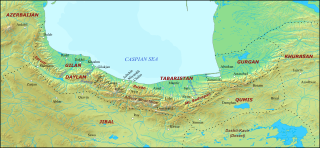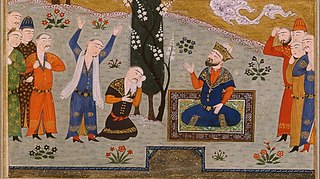
Mazyar was an Iranian prince from the Qarinvand dynasty, who was the ruler (ispahbadh) of the mountainous region of Tabaristan from 825/6 to 839. For his resistance to the Abbasid Caliphate, Mazyar is considered one of the national heroes of Iran by twentieth-century Iranian nationalist historiography. His name means "protected by the yazata of the moon".

The Bavand dynasty, or simply the Bavandids, was an Iranian dynasty that ruled in parts of Tabaristan in what is now northern Iran from 651 until 1349, alternating between outright independence and submission as vassals to more powerful regional rulers. They ruled for 698 years, which is the second longest dynasty of Iran after the Baduspanids.

The House of Karen, also known as Karen-Pahlav, was one of the Seven Great Houses of Iran during the rule of Parthian and Sassanian Empires. The seat of the dynasty was at Nahavand, about 65 km south of Ecbatana. Members of House of Karen were of notable rank in the administrative structure of the Sassanian empire in multiple periods of its four century-long history.

Tabaristan or Tabarestan, was a mountainous region located on the Caspian coast of northern Iran. It corresponded to the present-day province of Mazandaran, which became the predominant name of the area from the 11th-century onwards.
Surkhab I was the second ruler of the Bavand dynasty from ca. 673 to 717.
Sharwin I was the fifth ruler of the Bavand dynasty from 772 to 817. He was the son and successor of Surkhab II.
Surkhab II was the fourth ruler of the Bavand dynasty from 755 to 772.
Qarin I, was the eighth ruler of the Bavand dynasty from 839 to 867.
Sharwin II, was the tenth ruler of the Bavand dynasty from 896 to 930.
Qarin III, was the ruler of the Bavand dynasty from 1114 to 1117. He was the son and successor of Shahriyar IV.
Ardashir II was the ruler of the Bavand dynasty from 1238 to 1249. His grandmother was a sister of Rustam V, and he was also related to the Nizari Ismaili Jalaluddin Hasan through his mother.
Rustam II, was the twelfth ruler of the Bavand dynasty from 964 to 979. He was the brother and successor of Shahriyar II.

Shahriyar IV, also known by his honorific title Husam al-Dawla, was the king of the Bavand dynasty of Mazandaran, ruling from 1074 to 1114.
Rustam III, was the ruler of the Bavand dynasty from 1117 to 1118. He was the son and successor of Qarin III.
Sharwin III, was the fourteenth ruler of the Bavand dynasty briefly in 986. He was the brother and successor of al-Marzuban.
Shahriyar III, was the sixteenth ruler of the Bavand dynasty from 986 to 987, and briefly in 998 after a short disruption during his reign. He was the nephew and successor of Sharwin III.

Abu Ja'far Muhammad, was the ruler of the Bavand dynasty from an unknown date until his capture and defeat by the Kakuyids in 1027.

The Qarinvand dynasty, or simply the Karenids, was an Iranian dynasty that ruled in parts of Tabaristan (Mazandaran) in northern Iran from the 550s until the 11th-century. They considered themselves as the inheritors of the Dabuyid dynasty, and were known by their titles of Gilgilan and Ispahbadh. They were descended from Sukhra, a Parthian nobleman from the House of Karen, who was the de facto ruler of the Sasanian Empire from 484 to 493. The Qarinvand dynasty is also considered to be the one of the last Zoroastrian dynasties before the rise of the Islamic Iranian dynasties
Hasan I, was the ruler of the Bavand dynasty from 1165 to 1173. He was the son and successor of Shah Ghazi Rustam IV. He was murdered in 1173 by his Turkic slave-soldiers (ghilman) and was succeeded by his son Ardashir I.

Shah Ghazi Rustam, was king of the Bavand dynasty of Mazandaran, ruling from 1142 to 1165. He expanded the borders of the kingdom at the expense of his neighbors, particularly the Ismailis and the Seljuks. He established a Bavandid presence in Gilan as a result of his frequent vengeful raids against the Ismailis, who had assassinated his son and heir, Girdbazu. He also brought Qumis and Ray under Bavandid control during his wars against the Seljuks and the Karakhanids.